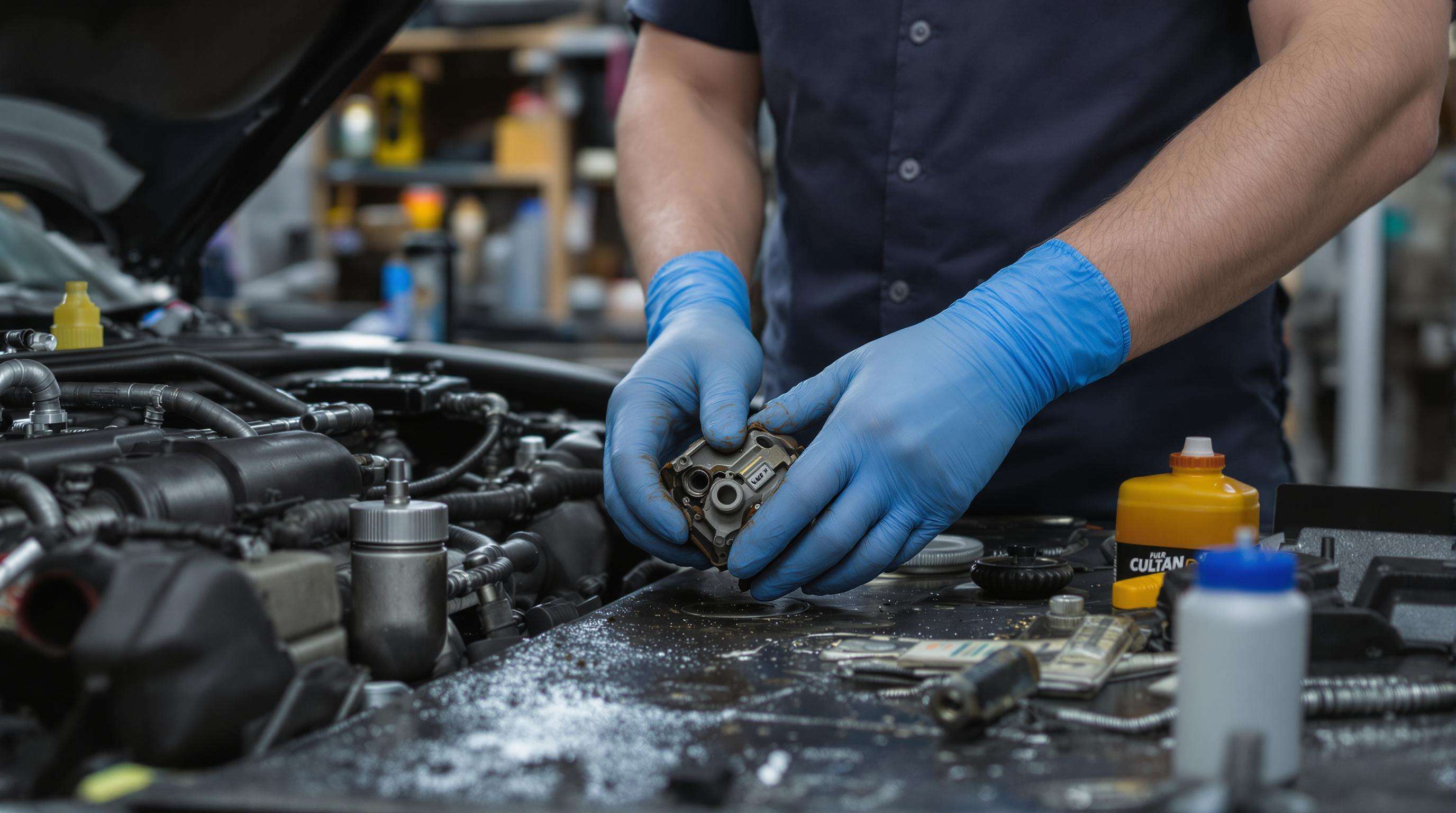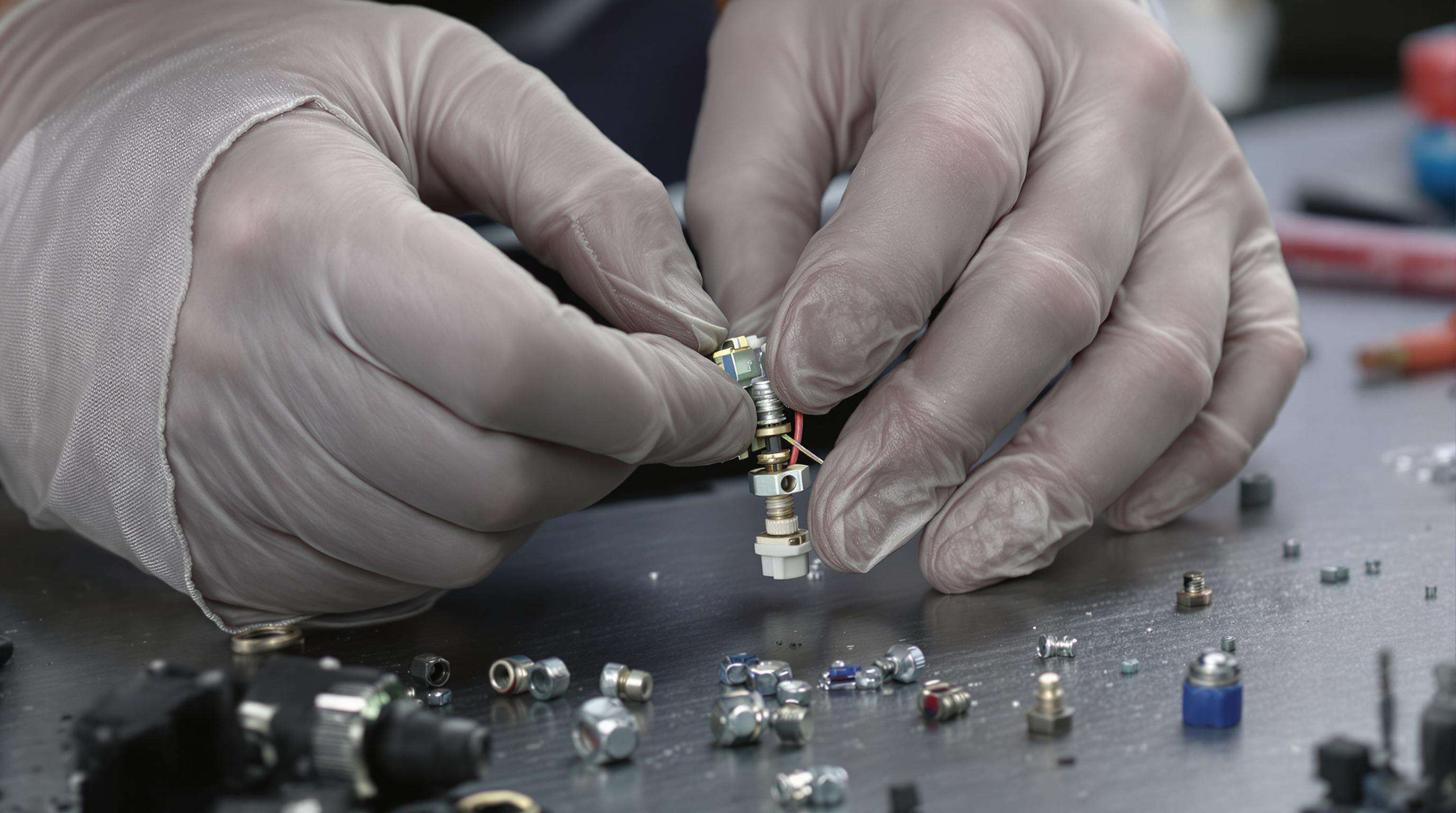
For automotive technicians working around all sorts of nasty stuff, latex gloves serve as a real protection against oils, greases, and solvents that can really mess up their hands. According to a recent 2023 safety study, mechanics who wore these gloves had way less direct contact with motor oil (about 89% less) and brake fluid (around 76% reduction) than those who worked without any protection on their hands. What makes these gloves so effective? They have those special water-repelling qualities that stop things like antifreeze and transmission fluid from soaking into the skin. And we're not just talking about comfort here either. The Centers for Disease Control actually connects exposure to these chemicals with serious issues like chemical burns and skin irritation among workers who don't take proper precautions.
Constant contact between skin and automotive pollutants raises chances for occupational dermatitis plus long term infection problems. According to recent CDC recommendations from 2022 on protective equipment, workers who wear gloves properly see about a 60 to 80 percent drop in skin contamination cases industry wide. Regular cotton gloves just don't cut it compared to latex alternatives which actually block tiny particles and stop liquids from soaking through. This matters a lot when dealing with harsh stuff like degreasing agents, battery acid spills, or leftover fuel residue on hands after maintenance work.
An auto repair shop located in Cleveland saw about 40 fewer cases of dirty hands among workers since they started using latex gloves when dealing with fluids. Before making the switch, around one out of every four mechanics complained about irritated skin each month, mostly because their hands got soaked in solvents and greasy stuff all day long. When management made wearing gloves compulsory for transferring liquids and cleaning parts, things changed pretty fast. Six months later, employee health checks revealed significant improvements across the board.
| Metric | Improvement |
|---|---|
| Hand irritation reports | 58% decrease |
| Fluid spill exposure | 72% reduction |
| Glove tear incidents | 9% of tasks |
Workers maintained this protocol using bulk-purchased latex gloves costing under $0.12/pair, demonstrating both health and economic viability.

Getting automotive repairs right requires working at the millimeter level when dealing with small parts like nuts, wires, and sensor components. Mechanics who don't wear good gloves tend to adjust their grip strength, which actually makes them slower and more prone to mistakes. According to a study published in Mechanical Engineering Quarterly back in 2023, latex gloves give about 23 percent better touch sensitivity compared to regular cotton work gloves. This means technicians can handle tiny bolts and electrical connectors much more effectively while maintaining their usual pace and accuracy on the job. The difference might seem small, but in auto shops where every second counts, those improvements really add up over time.
The material’s natural elasticity creates a “second skin” effect, conforming to knuckles and fingertips while maintaining 0.5mm thickness—thin enough to feel a 2mm screw head through the glove. Unlike rigid alternatives, latex stretches 300%—500% before tearing, allowing mechanics to exert force on seized parts without losing sensitivity.
During a three month workshop test, around 8 out of 10 technicians said they felt much better about working with electrical connectors when using latex gloves. The gloves let air through so hands don't get as tired during those long eight hour days at the bench. About seven in ten workers also mentioned dropping parts less often than when they worked without any protection on their hands. Of course, these gloves aren't great for jobs where there are sharp edges involved. Still, most mechanics stick with latex for things like checking engines or installing interior trim where being able to feel what's going on really matters.
Latex gloves stand up pretty well against those everyday automotive fluids we all deal with - think engine oil, grease, brake cleaner stuff. The way these gloves are made gives them a sort of shield effect that keeps most of those nasty hydrocarbons from soaking through into our skin. They handle quick contact with things like gasoline or transmission fluid just fine, but watch out if they stay in touch with certain synthetic oils that have those ester additives mixed in. We've seen some breakdown happen after extended periods (Occupational Safety Review mentioned this back in 2023). Makes sense really, since nothing lasts forever when exposed to harsh chemicals continuously.
Latex gloves stretch really well around fingers and hands, which means they stick close to the skin without getting caught on things. This is super important for jobs where people work with belts or clean battery terminals all day long. Tests run by manufacturers indicate that latex holds up against wear and tear about 35 percent longer than regular vinyl gloves when working with metal stuff. But there's a catch worth mentioning. When workers keep stretching their gloves over sharp edges in engines, especially those rusty old bolts that nobody wants to touch, tiny holes start forming in the material over time. These small tears might not seem big at first glance, but they definitely compromise protection levels eventually.
Latex gloves just don't hold up well when working with tools that apply serious force, such as impact wrenches or when trying to get those stubborn parts unstuck. According to research from a workshop back in 2022, nearly a quarter (around 22%) of latex gloves got punctured simply by mechanics dealing with sheet metal edges on regular days at work. When it comes down to jobs where there's grinding involved or fixing hydraulic lines, most experienced technicians will switch to thicker nitrile gloves instead. These offer better protection against cuts while still standing up to chemicals, making them far more practical for these kinds of demanding tasks across auto shops and industrial settings alike.
In auto shops dealing with oily tools and slick floors every day, latex gloves really stand out for their grip. The natural rubber texture actually grabs hold of greasy engine bits and transmission parts that would otherwise slip right through fingers. Some recent testing back in 2023 showed these gloves maintain about 40% more grip on oily bolts compared to just using bare hands. What makes them different from those bulkier work gloves is how they mold to the shape of hands yet still keep that sticky surface needed for jobs like tightening fuel lines or messing with brake calipers without constantly dropping tools all over the floor.
Looking at what happens in six different repair shops shows something interesting about gloves. Mechanics who wore latex gloves dropped tools about two thirds less often than those with cotton gloves when working in greasy or wet situations. These latex gloves seem to work better because they wick away moisture and bounce back after stretching, which keeps fingers from slipping while doing things like fixing coolant systems or changing oil filters. But there's a catch too. After spending around four to five hours handling automatic transmission fluid, most techs find their grip starts to slip. That's why many shops now switch out gloves halfway through long transmission jobs just to keep that good feel between hand and tool.
For automotive techs doing everyday repairs, latex gloves offer good value at around 12 to 18 cents each, way cheaper than those heavy duty options that run from 35 to 60 cents apiece. The money saved adds up fast since these gloves work great for all those repetitive jobs we do constantly throughout the day. Think about changing air filters, checking batteries, or looking at fluid levels where hands get dirty multiple times an hour. Shops that switched entirely to latex gloves saw their spending on hand protection drop by about 17% last year according to the Automotive Maintenance Trends Report 2023. Most mechanics just grab another pair whenever they need it without thinking twice about the cost.
Purchasing latex gloves in bulk quantities (500+ pairs) reduces per-unit costs by up to 22%, according to the 2024 Automotive Workshop Economics Report. Standardized glove sizing and packaging simplify inventory management, with most shops maintaining 2—3 week supplies. Key benefits include:
Latex gloves cover most of the everyday jobs in auto repair shops, handling around 85 to 90 percent of general tasks. But many garages are now mixing things up with different types of gloves depending on the job. When mechanics get into heavy engine work where hands will be submerged in oil, they typically switch to nitrile gloves instead. For suspension work where there's risk of punctures from sharp parts, impact resistant gloves become necessary. By using latex gloves mainly for lighter repairs and reserving other options for specialized tasks, shops can stretch their budget further. The numbers back this up too - workshops that implemented these mixed glove strategies saw about a 31 percent reduction in overall PPE costs according to industry surveys.
Latex gloves provide protection against oils, greases, and solvents, reducing skin exposure by blocking contaminants. They enhance dexterity and grip, allowing technicians to perform precise tasks more effectively while remaining cost-effective.
Latex gloves may not hold up well under high-torque or sharp-tool environments, where thicker nitrile gloves offer better protection against punctures and cuts.
Latex gloves offer better tactile sensitivity compared to cotton gloves and block contaminants more effectively. However, for specific tasks involving heavy oil exposure or sharp objects, nitrile or impact-resistant gloves are recommended.


Copyright © 2024 Sichuan Samson Technology Co., Ltd - Privacy policy